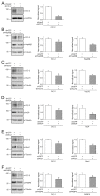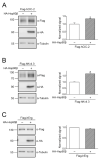Regulation of ClC-2 Chloride Channel Proteostasis by Molecular Chaperones: Correction of Leukodystrophy-Associated Defect
- PMID: 34070744
- PMCID: PMC8197790
- DOI: 10.3390/ijms22115859
Regulation of ClC-2 Chloride Channel Proteostasis by Molecular Chaperones: Correction of Leukodystrophy-Associated Defect
Abstract
The ClC-2 channel plays a critical role in maintaining ion homeostasis in the brain and the testis. Loss-of-function mutations in the ClC-2-encoding human CLCN2 gene are linked to the white matter disease leukodystrophy. Clcn2-deficient mice display neuronal myelin vacuolation and testicular degeneration. Leukodystrophy-causing ClC-2 mutant channels are associated with anomalous proteostasis manifesting enhanced endoplasmic reticulum (ER)-associated degradation. The molecular nature of the ER quality control system for ClC-2 protein remains elusive. In mouse testicular tissues and Leydig cells, we demonstrated that endogenous ClC-2 co-existed in the same protein complex with the molecular chaperones heat shock protein 90β (Hsp90β) and heat shock cognate protein (Hsc70), as well as the associated co-chaperones Hsp70/Hsp90 organizing protein (HOP), activator of Hsp90 ATPase homolog 1 (Aha1), and FK506-binding protein 8 (FKBP8). Further biochemical analyses revealed that the Hsp90β-Hsc70 chaperone/co-chaperone system promoted mouse and human ClC-2 protein biogenesis. FKBP8 additionally facilitated membrane trafficking of ClC-2 channels. Interestingly, treatment with the Hsp90-targeting small molecule 17-allylamino-17-demethoxygeldanamycin (17-AAG) substantially boosted ClC-2 protein expression. Also, 17-AAG effectively increased both total and cell surface protein levels of leukodystrophy-causing loss-of-function ClC-2 mutant channels. Our findings highlight the therapeutic potential of 17-AAG in correcting anomalous ClC-2 proteostasis associated with leukodystrophy.
Keywords: 17-AAG; channelopathy; chaperone; co-chaperone; protein quality control; proteostasis.
Conflict of interest statement
The authors declare no competing financial interests.
Figures










Similar articles
-
Regulation of CLC-1 chloride channel biosynthesis by FKBP8 and Hsp90β.Sci Rep. 2016 Sep 1;6:32444. doi: 10.1038/srep32444. Sci Rep. 2016. PMID: 27580824 Free PMC article.
-
CUL4-DDB1-CRBN E3 Ubiquitin Ligase Regulates Proteostasis of ClC-2 Chloride Channels: Implication for Aldosteronism and Leukodystrophy.Cells. 2020 May 26;9(6):1332. doi: 10.3390/cells9061332. Cells. 2020. PMID: 32466489 Free PMC article.
-
Silencing of HSP90 cochaperone AHA1 expression decreases client protein activation and increases cellular sensitivity to the HSP90 inhibitor 17-allylamino-17-demethoxygeldanamycin.Cancer Res. 2008 Feb 15;68(4):1188-97. doi: 10.1158/0008-5472.CAN-07-3268. Cancer Res. 2008. PMID: 18281495
-
Heat Shock Protein 70 (HSP70) Induction: Chaperonotherapy for Neuroprotection after Brain Injury.Cells. 2020 Sep 2;9(9):2020. doi: 10.3390/cells9092020. Cells. 2020. PMID: 32887360 Free PMC article. Review.
-
The Hsp70-Hsp90 Chaperone Cascade in Protein Folding.Trends Cell Biol. 2019 Feb;29(2):164-177. doi: 10.1016/j.tcb.2018.10.004. Epub 2018 Nov 28. Trends Cell Biol. 2019. PMID: 30502916 Review.
Cited by
-
Regulation of testosterone synthesis in Leydig cells by ClC-2 chloride channel.Reproduction. 2025 Jul 18;170(2):e240432. doi: 10.1530/REP-24-0432. Print 2025 Aug 1. Reproduction. 2025. PMID: 40683311 Free PMC article.
-
Restoration of Shal/KV4 proteostasis and motor function in a Drosophila model of spinocerebellar ataxia type 19/22.Cell Mol Life Sci. 2025 Apr 28;82(1):181. doi: 10.1007/s00018-025-05711-y. Cell Mol Life Sci. 2025. PMID: 40293501 Free PMC article.
References
MeSH terms
Substances
Grants and funding
LinkOut - more resources
Full Text Sources
Molecular Biology Databases
Research Materials
Miscellaneous

